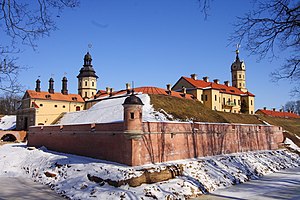Nesvizh Castle
| UNESCO World Heritage Site | |
|---|---|
 | |
| Criteria | Cultural: ii, iv, vi |
| Reference | 1196 |
| Inscription | 2005 (29th Session) |
Nesvizh Castle or Niasvizh Castle ([Нясвіжскі замак, Niasvižski zamak] Error: {{Lang-xx}}: text has italic markup (help), [Несвижский замок, Nesvizhskiy zamok] Error: {{Lang-xx}}: text has italic markup (help), Polish: Nieświeski zamek) is a residential castle of the Radziwill family in Nesvizh in Belarus.
History
The estate was owned by the Radziwiłł Belarus magnate family from 1533, when it was awarded to Mikołaj Radziwiłł and his brother Jan Radziwiłł after the extinction of the Kiszka family. Since the Radziwills were one of the most important and wealthy clans of the Grand Duchy of Lithuania, it was there that the Lithuanian Archive was moved in 1551. In 1586 the estate was turned into an ordynacja.
In 1582 Mikołaj Krzysztof "Sierotka" Radziwiłł, the Marshal of Lithuania, voivode of Trakai and Vilnius and castellan of Šiauliai, started the construction of an imposing square three-storey chateau. Although the works were based on a pre-existing structure of a mediæval castle, the former fortifications were entirely turned into a renaissance-baroque house. Construction was completed by 1604, and they added several galleries half a century later. The château's corners were fortified with four octagonal towers.
In 1706, during the Great Northern War, Charles XII's army sacked the castle and destroyed its fortifications. Several decades later, the Radziwills invited some German and Italian architects to substantially renovate and enlarge the chateau. Antoni Zaleski decorated its yellow facades with baroque stucco work. The 16th-century castle gates were also reconstructed, and the two-storey gatehouse tower was crowned with a helm. It was at this time that the three separate buildings surrounding the central courtyard were joined into a single structure.
The most important structure in Nesvizh is the Corpus Christi Church (picture) (1587 to 1603), connected with the castle by a dam over a ditch and containing coffins of 72 members of the Radziwill family, each interred in a simple coffin made of birch and marked with Trąby Coat of Arms. Designed by the Italian architect Gian Maria Bernardoni (1541 to 1605), the church is considered the first Jesuit temple patterned after Il Gesù in Rome, the first domed basilica with Baroque facade in the world and the first baroque piece of architecture in Eastern Europe.
Apart from elaborate princely sepulchres, its interior features some late baroque frescoes from 1760s and the Holy Cross altar, executed by Venetian sculptors in 1583.

In 1770 the castle was seized by Russian forces and the Radziwill family was expelled. Soon afterwards the Lithuanian Archive was transferred to Saint Petersburg (where it remains), while the majority of works of art gathered in the palace were distributed among various Russian nobles. Abandoned both by the original owners and by the Russian army, the palace gradually fell into disrepair. However, it was restored by the Radziwills and between 1881 and 1886 the castle's interiors were renovated by Prince Anton Radizwill and his French wife, Marie de Castellane. They also designed a landscape park in English style. With an area of more than one square kilometre, the park is one of the biggest such facilities in Europe.
In 1939, the Radziwill family was expelled from the castle by the invading Red Army. In Soviet times, the chateau was used a sanatorium, while the park gradually fell in neglect.
In 1994, the castle complex was designated the national historical and cultural reserve. Twelve years later, the castle complex was inscribed on the World Heritage List.
Reconstruction
The ongoing reconstruction has drawn sharp criticism for its "unjustified reconstruction" of several long-demolished structures, notably a bell-tower. In 2002, the upper storey of the residence was destroyed by fire. Six years later, the Belarus edition of the Komsomolskaya Pravda reported that a substantial section of the castle, dating from the 18th century, had been entirely demolished on account of "rotten brick" (see photo).
Other Radziwill residences
- Biržai Castle
- Dubingiai Castle
- Mir Castle
- Olyka Castle
- Radziwiłł Palace in Warsaw
- Radziwiłł Palace in Vilnius
